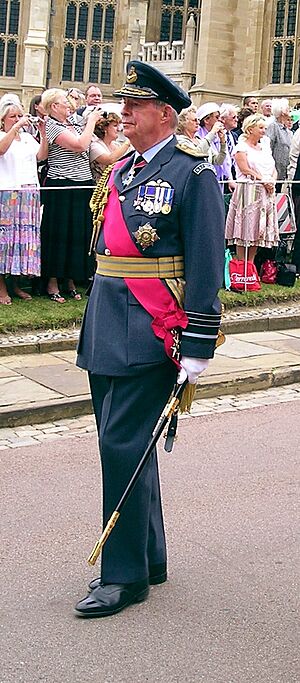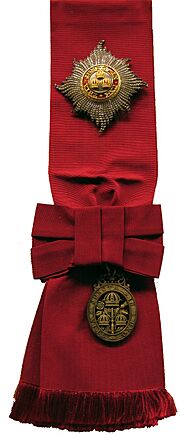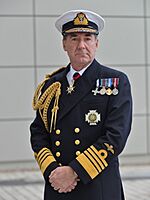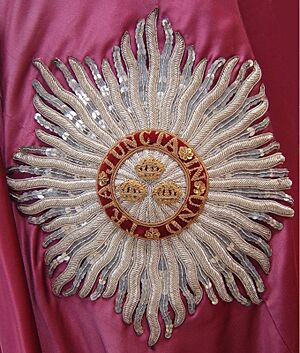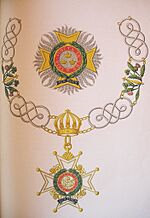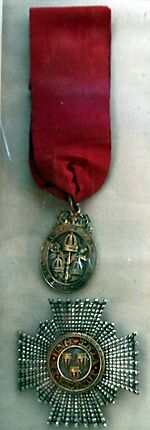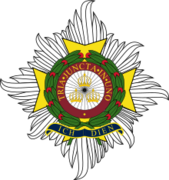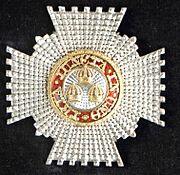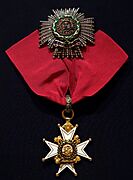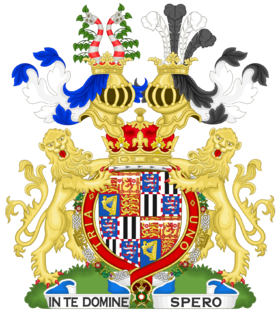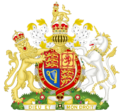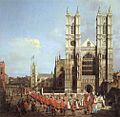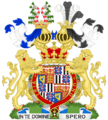Order of the Bath facts for kids
Quick facts for kids Most Honourable Order of the Bath |
|
|---|---|
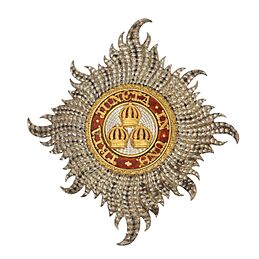
Breast star of a Knight/Dame Grand Cross (Civil Division)
|
|
| Awarded by the monarch of the United Kingdom |
|
| Type | Order of chivalry |
| Established | 18 May 1725 |
| Country | United Kingdom |
| Motto | Tria juncta in uno ('Three joined in one') (Civil Division) Ich dien ('I serve') (Military Division) |
| Awarded for | Service to the Crown |
| Status | Currently constituted |
| Founder | George I |
| Sovereign | Charles III |
| Great Master | William, Prince of Wales |
| Grades | Knight/Dame Grand Cross (GCB) Knight/Dame Commander (KCB/DCB) Companion (CB) |
| Former grades | Knight Companion (KB) |
| Precedence | |
| Next (higher) | Order of St Patrick |
| Next (lower) | Order of the Star of India |
Order of the Bath ribbon bar |
|
The Most Honourable Order of the Bath is a special award given in Britain. King George I started it on May 18, 1725. This award usually goes to important people in the military or senior government workers. The King or Queen gives out these awards based on advice from the government.
The name "Bath" comes from an old medieval ceremony. In this ceremony, a person becoming a knight would take a special bath. This bath was a symbol of becoming pure. Even though not all knights had this full ceremony, those who did were called "knights of the Bath."
King George I made the Knights of the Bath into a formal military order. This meant it was a group of knights with rules and new members could join when there were openings.
The Order includes the Sovereign of the United Kingdom (currently King Charles III). It also has a Great Master (currently William, Prince of Wales). There are three main levels of members:
- Knight Grand Cross (GCB) or Dame Grand Cross (GCB);
- Knight Commander (KCB) or Dame Commander (DCB); and
- Companion (CB).
Members belong to either the Civil Division (for government service) or the Military Division (for military service). Before 1815, there was only one level, Knight Companion (KB), but that is no longer an option. People from other Commonwealth countries or foreign nations can also become honorary members.
The Order of the Bath is the fourth most important of the British awards for bravery and service. It comes after the Order of the Garter, the Order of the Thistle, and the Order of St Patrick (which is not currently active).
Contents
History of the Order of the Bath
Early Knights of the Bath
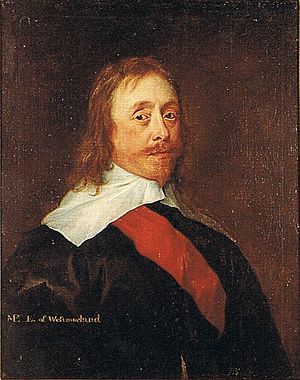
In the Middle Ages, becoming a knight often involved special ceremonies. These ceremonies usually included the knight-to-be taking a bath. This bath was a symbol of spiritual cleanliness. During the bath, older knights would teach the new knight about his duties.
After the bath, the knight-to-be would rest and then go to a chapel. There, he would spend the night in a vigil, praying and thinking. At dawn, he would confess and attend a church service. Later, he would be brought before the King. The King would then give him a belt and strike him on the neck with a hand or a sword. This strike, called an accolade, was the most important part of becoming a knight.
Over time, a simpler ceremony developed. Knights could be created just by touching their shoulder with a sword, or 'dubbing' them. This is still done today. In early times, the full ceremonies were often used for people from very important families.
From the coronation of Henry IV in 1399, the full ceremonies were only used for big royal events. These included coronations, special ceremonies for the Prince of Wales, or royal weddings. The knights created this way were known as Knights of the Bath. The last time Knights of the Bath were created in this way was at the coronation of Charles II in 1661.
Since at least 1625, Knights of the Bath used the motto Tria juncta in uno. This is Latin for 'Three joined in one'. They also wore a badge with three crowns inside a gold oval. These symbols were later used by the formal Order of the Bath. The meaning of 'Three joined in one' might refer to the kingdoms of England, Scotland, and either France or Ireland. It could also refer to the Holy Trinity.
Starting the Order
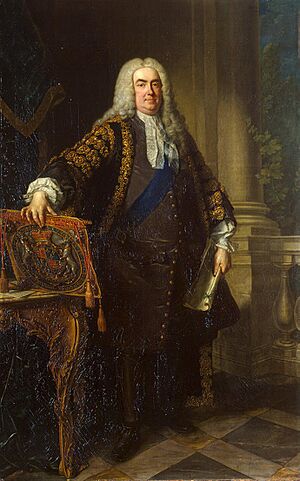
The idea to create the Order of the Bath came from John Anstis, who was the Garter King of Arms. This was England's top expert in heraldry (coats of arms). He wanted to make his position more important and help the government.
In the early 1700s, awards were different from today. There were not many ways to honor people for their achievements. The King still had a lot of power and needed ways to reward his supporters in Parliament.
Sir Robert Walpole, who was the Prime Minister, saw the new Order as a way to gain political support. He made sure that many of the first 36 members were important politicians. King George I agreed to Walpole's idea. Anstis then wrote the rules for the Order of the Bath. He used the old motto and badge of the Knights of the Bath. He also used the same color for the riband (sash) and mantle (cloak). The Order was officially started on May 18, 1725.
The Order first had the Sovereign, a Prince of the Royal family, a Great Master, and 35 Knights Companion. Seven officers also helped run the Order. These positions were often given as rewards. Even though it was called a military Order, only a few military officers were among the first members. Most were politicians or royal staff.
The first Knights Companion were formally recognized by the King on May 27, 1725. The old medieval ceremonies were not fully performed. Instead, a special ceremony called an Installation was held in the Order's Chapel. This chapel is the Henry VII Lady Chapel in Westminster Abbey. This tradition continued until 1812.
At first, appointments to the Order were mostly for political reasons. But from the 1770s, more people were chosen for their achievements in the navy, military, or diplomacy. This was because Britain was involved in many conflicts during this time. The Peninsular War led to so many deserving military officers that extra knights could be appointed during wartime.
Changes in 1815
In January 1815, after the Peninsular War ended, the Prince Regent (who later became George IV) made the Order of the Bath much bigger. He wanted to honor officers who had shown great bravery during the war.
The Order now had three levels: Knights Grand Cross, Knights Commander, and Companions. The existing 60 Knights Companion became Knights Grand Cross. This top level was limited to 72 members. Twelve of these could be for civil or diplomatic service. Military members had to be at least a major-general or rear admiral.
Knights Commander were limited to 180 members. They had to be at least a lieutenant-colonel or post-captain. The number of Companions was not limited. They had to have received a medal or been mentioned for bravery in official reports since 1803. This large increase in members caused some people to worry that the Order would lose its special status.
Modern Times
In 1847, Queen Victoria made new rules. These rules removed all mentions of the Order being only for the military. This meant that the Knight Commander and Companion levels could also be given for civil service. The Order was then split into Military and Civil Divisions. The old medieval ceremonies were removed, but a formal Investiture ceremony was introduced. In this ceremony, the Sovereign would wear the Order's special clothes and symbols.
In 1910, George V brought back the Installation ceremony. This ceremony took place on July 22, 1913, in the Henry VII Chapel. Installations have been held regularly since then.
In 1971, women were allowed to join the Order. Jean Nunn was the first woman to be admitted in 1971. In 1975, Princess Alice, Duchess of Gloucester, who was Elizabeth II's aunt, became the first woman to reach the highest rank, Dame Grand Cross.
Who Belongs to the Order?
The Sovereign
The British King or Queen is the head of the Order of the Bath. The Sovereign makes all appointments to the Order. However, they do so based on advice from the Government.
The Great Master

The second most important member is the Great Master. The current Great Master is William, Prince of Wales. This person is usually a member of the Royal family. The Great Master is in charge of the Order's official seal and makes sure the rules are followed.
Members of the Order
The rules allow for a certain number of members in each level:
- 120 Knights or Dames Grand Cross (GCB)
- 355 Knights Commander (KCB) or Dames Commander (DCB)
- 1,925 Companions (CB)
Most members are citizens of the United Kingdom or other Commonwealth countries where the British monarch is the head of state. They are usually high-ranking officers in the armed forces or senior government officials.
People appointed to the Civil Division must have given "personal services to the crown or performed public duties" that deserve royal recognition. For the Military Division, members must hold a certain. For example, GCBs are usually admirals, generals, or air chief marshals. KCBs are typically vice admirals, lieutenant generals, or air marshals. CBs are often rear admirals, major generals, or air vice marshals.
People from other countries can become honorary members. For example, Queen Elizabeth II often made visiting heads of state honorary GCBs. Famous military leaders from other countries have also received honorary appointments. One example is General Dwight D. Eisenhower during the Second World War.
Honorary members do not count towards the set number of members in each class. The Sovereign can also go over the limits during wartime or other special situations.
Officers of the Order
The Order of the Bath has six officers who help run it:
- The Dean is the Dean of Westminster.
- The King of Arms is responsible for the Order's heraldry.
- The Registrar and Secretary manages the Order's records.
- The Deputy Secretary assists the Registrar and Secretary.
- The Genealogist helps with family histories related to the Order.
- The Lady Usher of the Scarlet Rod is an official who helps with ceremonies.
What Members Wear
Members of the Order wear special uniforms for important events. These uniforms are different depending on their rank.
The mantle (a long cloak) is worn only by Knights and Dames Grand Cross. It is made of crimson (dark red) satin and has a star design on the left side.
The hat is worn by Knights and Dames Grand Cross and Knights and Dames Commander. It is made of black velvet and has a plume of feathers.
The collar is a heavy gold chain worn only by Knights and Dames Grand Cross. It has designs of crowns and flowers (roses for England, thistles for Scotland, and shamrocks for Ireland).
For less formal occasions, simpler symbols are used: The star is worn by Knights and Dames Grand Cross and Knights and Dames Commander. It is pinned to the left side of the chest.
- The star for military Knights and Dames Grand Cross has a Maltese Cross on an eight-pointed silver star.
- The star for military Knights and Dames Commander is an eight-pointed silver cross.
Both military stars have three crowns in the center, surrounded by a red ring with the Order's motto. They also have laurel branches and the words Ich dien (old German for 'I serve').
- The star for civil Knights and Dames Grand Cross is an eight-pointed silver star without the Maltese cross.
- The star for civil Knights and Dames Commander is an eight-pointed silver cross.
These civil stars are similar to the military ones but do not have the laurel branches or the words Ich dien.
The badge is worn on a crimson ribbon. Its size and how it is worn depend on the rank and division. Knights and Dames Grand Cross wear it on a wide ribbon (sash) from the right shoulder to the left hip. Knights Commander and male Companions wear it from a ribbon around their neck. Dames Commander and female Companions wear it from a bow on their left side.
- The military badge is a white Maltese Cross with gold balls and small lion figures. It has three crowns on one side and a rose, thistle, and shamrock on the other. Both sides are surrounded by a red ring with the motto and Ich dien.
- The civil badge is a plain gold oval. It has three crowns on one side and a rose, thistle, and shamrock on the other. Both sides are surrounded by a ring with the motto.
On certain special days, members can wear the Order's collar over their uniform or evening clothes. The badge hangs from the collar on these days.
The collars and badges of Knights and Dames Grand Cross are returned to the Crown when the owner passes away. Other symbols can be kept by their owners.
The Order's Chapel
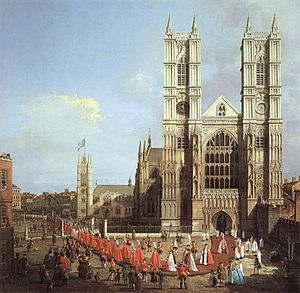

The official Chapel of the Order is the Henry VII Lady Chapel inside Westminster Abbey. The Sovereign, Great Master, and the Knights and Dames Grand Cross have special seats, called stalls, in the chapel's choir. Above these stalls, their heraldic devices (symbols from their coats of arms) are displayed.
Every four years, a special installation ceremony and religious service are held in the chapel. The Great Master leads this event. The last service was on Friday, May 16, 2025, led by the King and the Prince of Wales.
Because there are only a limited number of stalls, only the most senior Knights and Dames Grand Cross are installed. When a stall becomes empty, it is offered to the next most senior member who has not yet been installed. Sometimes, people wait a very long time between joining the Order and being installed.
Above each stall, you can see the member's heraldic symbols. On top of a knight's stall is his helmet, decorated with a mantling (fabric) and topped by his crest. For women (Dames), a coronet (small crown) is used instead of a helmet if they are a peer or a member of the Royal family.
Above the crest or coronet, the knight's or dame's heraldic banner hangs. This banner shows their coat of arms. On the back of the stall, there is a small brass plate. This 'stall plate' shows the member's name, coat of arms, and the date they joined the Order.
When a Knight passes away, their banner, helmet, mantling, and crest are taken down. However, the stall plates are never removed. They stay permanently attached to the stalls. This creates a colorful record of all the Knights and Dames who have been part of the Order throughout history.
Special Privileges
Order of Importance
Members of the Order of the Bath are given special positions in the order of precedence. This means they are ranked in a certain order for formal events. The wives of male members also have a place in this order. However, the husbands or other relatives of female members do not get any special ranking.
Knights Grand Cross and Knights Commander can use 'Sir' before their first name. Dames Grand Cross and Dames Commander can use 'Dame'. The wives of Knights can use 'Lady' before their last name. However, this does not apply to husbands of Dames. These titles are not used by peers (like Dukes or Earls) or princes. Also, honorary foreign members and church leaders do not get the 'Sir' title unless they later become British citizens.
Members also use special letters after their names. Knights and Dames Grand Cross use GCB. Knights Commander use KCB. Dames Commander use DCB. Companions use CB.
Coats of Arms
Knights and Dames Grand Cross can also have special supporters (figures on either side) for their coat of arms. They can also show their coat of arms surrounded by a red circle (the circlet) with the Order's motto and badge.
Knights and Dames Commander and Companions can show the circlet around their arms, but not the collar. Military members can also add two laurel branches and the words Ich dien to their coat of arms.
Members of the Order of the Bath and their children can get married in Westminster Abbey in London.
Membership Revocation
It is possible for someone to lose their membership in the Order. In the past, reasons for this included serious crimes or running away from battle. If a Knight was removed, their stall plate would be taken down from the chapel.
Only two people were officially removed in the early days for political reasons: Lord Cochrane in 1813 and Eyre Coote in 1816. Lord Cochrane was later given his membership back.
Today, membership can be canceled if a member is found to have done something dishonorable. The King or Queen makes this decision based on advice from a government minister. These cancellations can sometimes be reversed.
For example, in 1940, the Italian leader Benito Mussolini was stripped of his honorary Knight Grand Cross title after he declared war on the UK. In 2008, Robert Mugabe, the President of Zimbabwe, lost his honorary GCB. This was due to concerns about human rights and democracy in Zimbabwe.
Current Sovereign and Great Master
| Name | Year of appointment | Present age |
|---|---|---|
| Charles III (ex officio) | 1974 as Great Master as The Prince of Wales; Sovereign since 2022 | 77 |
| William, Prince of Wales KG, KT, GCB, PC, ADC(P) | 2024 | 43 |
Images for kids
-
Mildmay Fane, 2nd Earl of Westmorland, KB, with sash, c. 1630
-
Sir Robert Walpole, who as Prime Minister used the Order for political patronage
-
Prince Albert, the Prince Consort, Great Master 1843–1861. During the 19th century, Knights Grand Cross wore their mantles over imitations of 17th-century dress. They now wear them over contemporary attire.
-
Westminster Abbey with a procession of Knights of the Bath, by Canaletto, 1749.
-
Banners of the senior Knights and Dames Grand Cross of the Order of the Bath in the Henry VII Lady Chapel in Westminster Abbey.
See also
 In Spanish: Orden del Baño para niños For people who have been appointed to the Order of the Bath, see the following categories:
In Spanish: Orden del Baño para niños For people who have been appointed to the Order of the Bath, see the following categories:
- Category: Knights Grand Cross of the Order of the Bath
- Category: Dames Grand Cross of the Order of the Bath
- Category: Knights Commander of the Order of the Bath
- Category: Dames Commander of the Order of the Bath
- Category: Knights Companion of the Order of the Bath
- List of knights and dames grand cross of the Order of the Bath
- List of knights companion of the Order of the Bath
- Category: Knights of the Bath
- Category: Companions of the Order of the Bath
- List of honorary British knights and dames
- List of people who have declined a British honour
- List of revocations of appointments to orders and awarded decorations and medals of the United Kingdom


